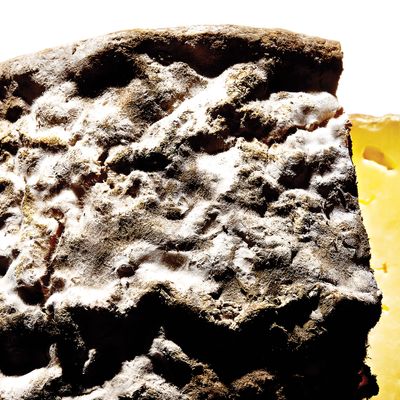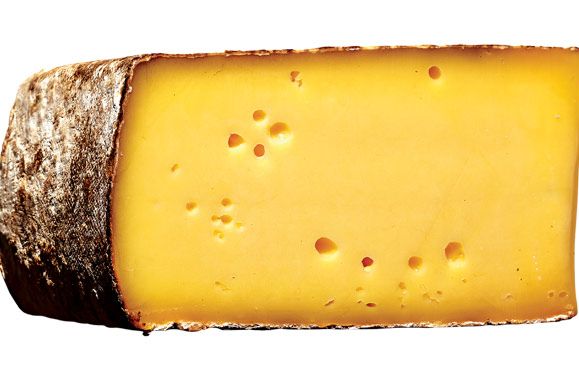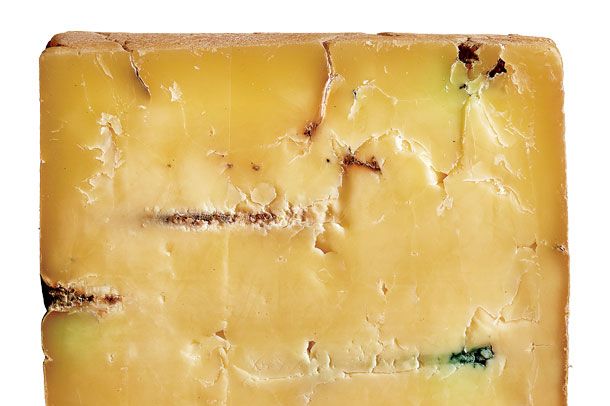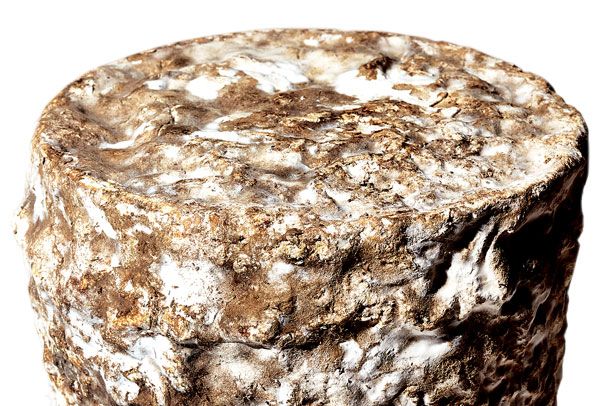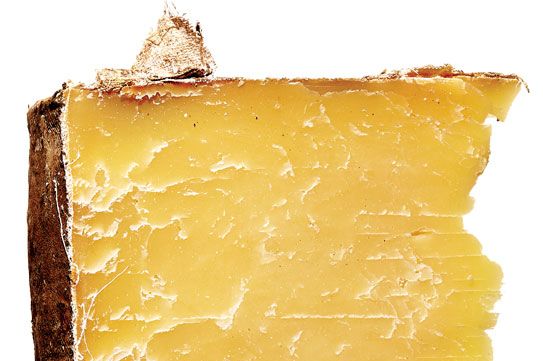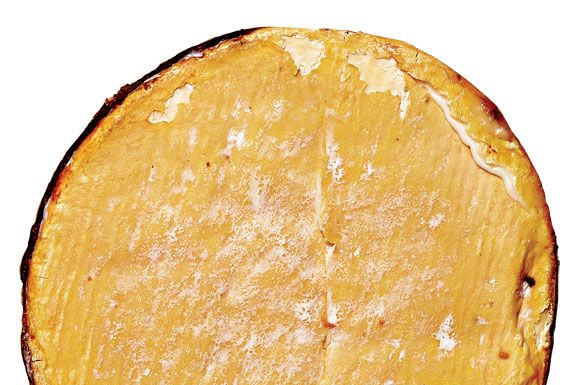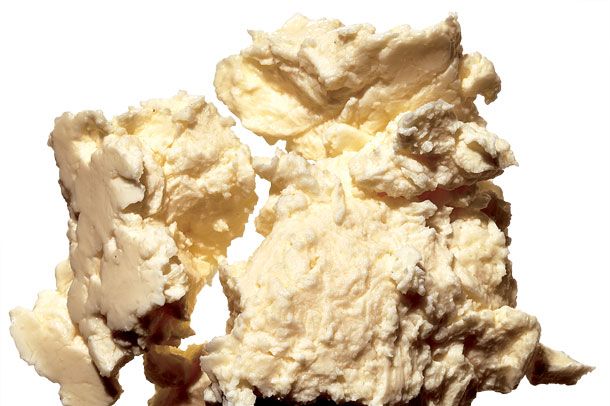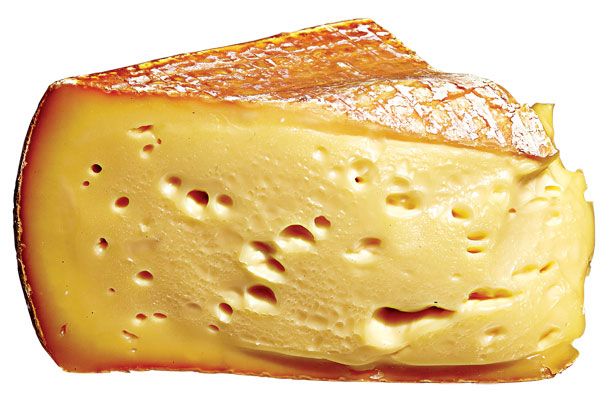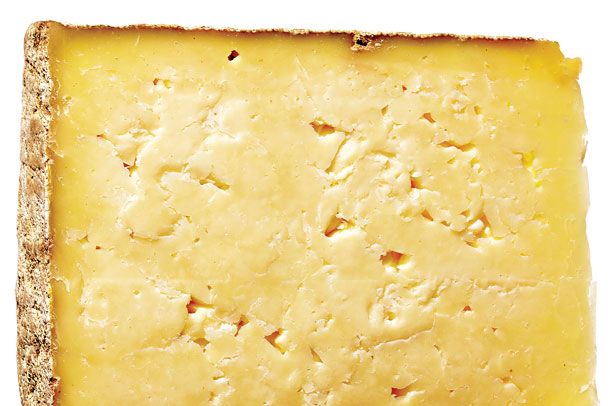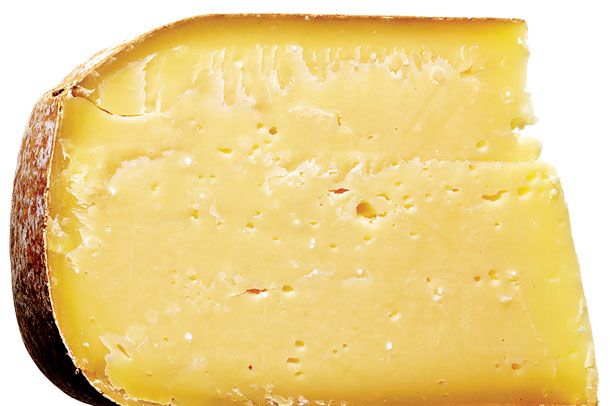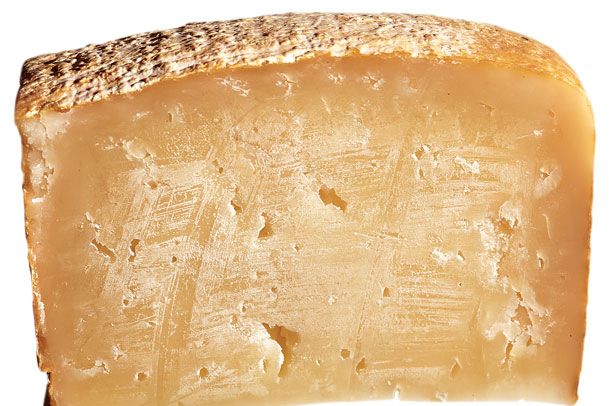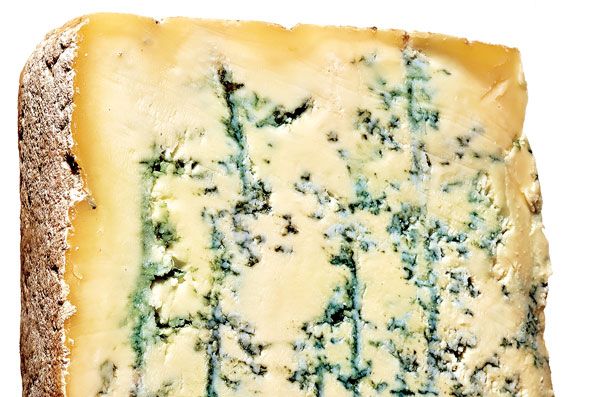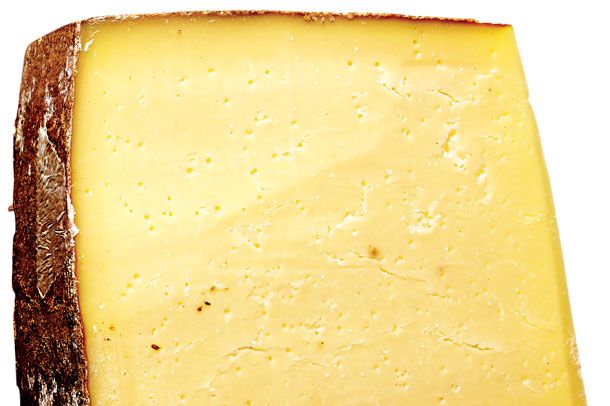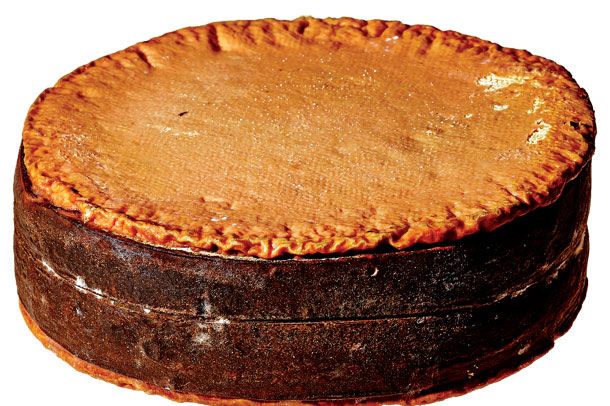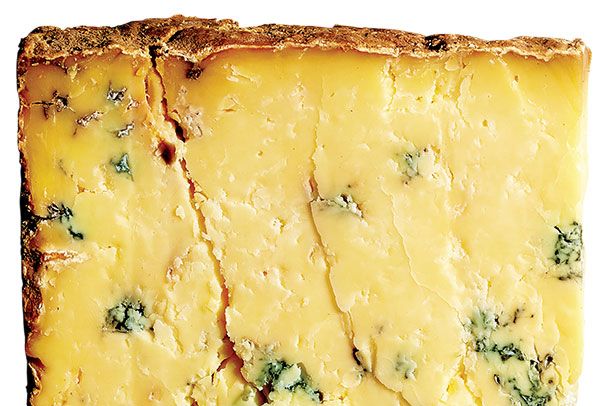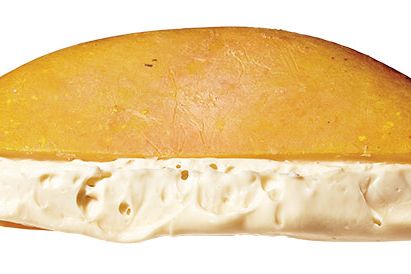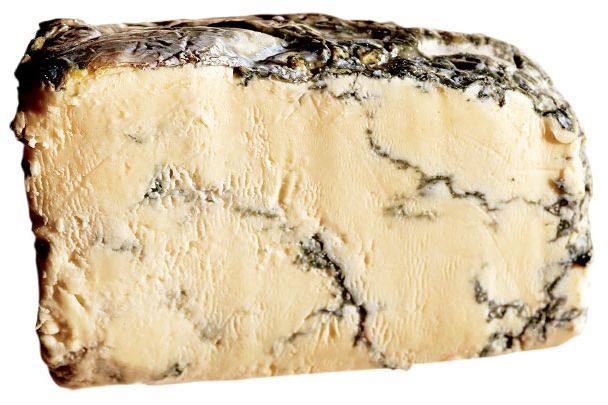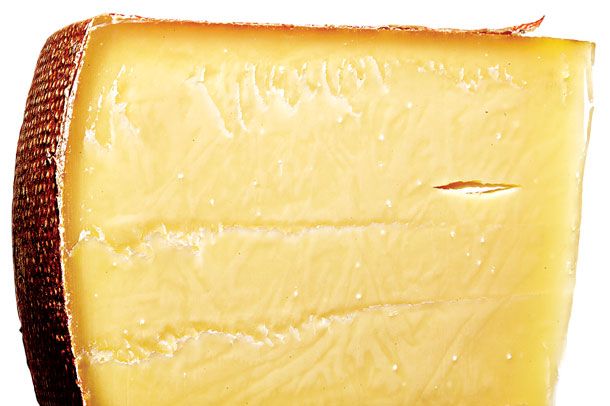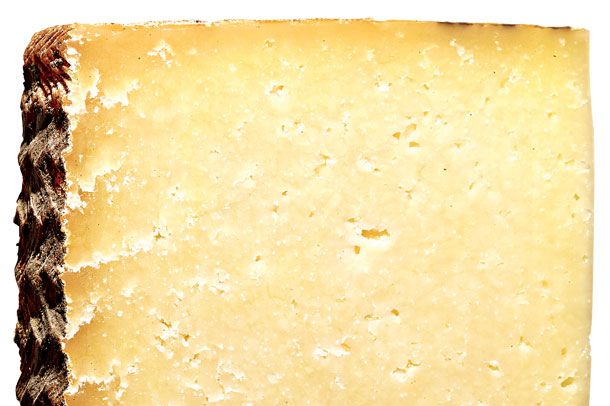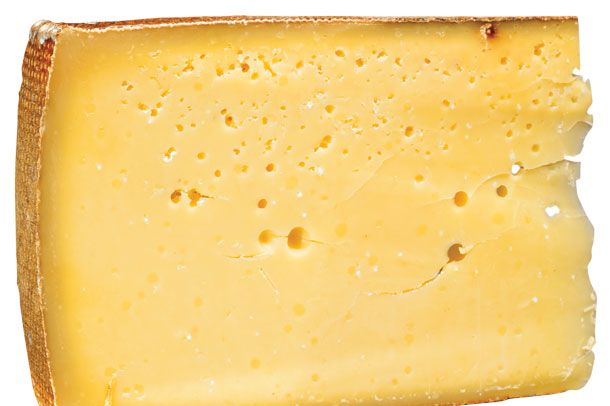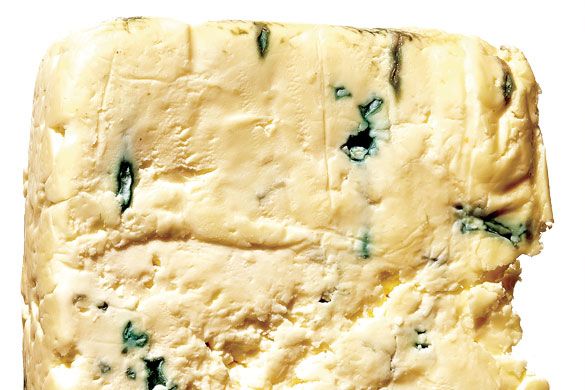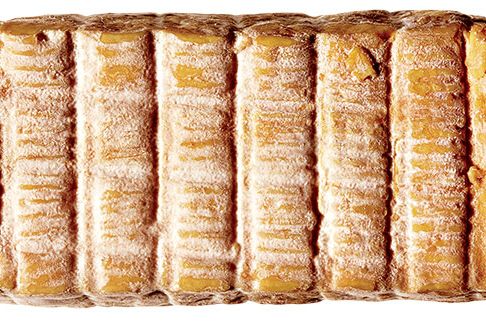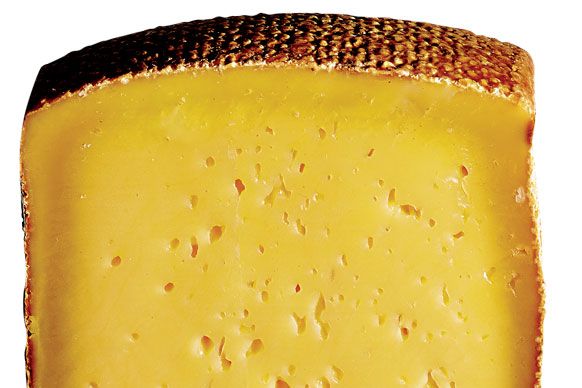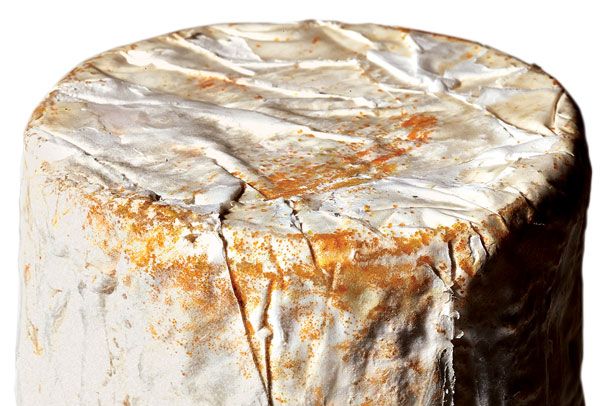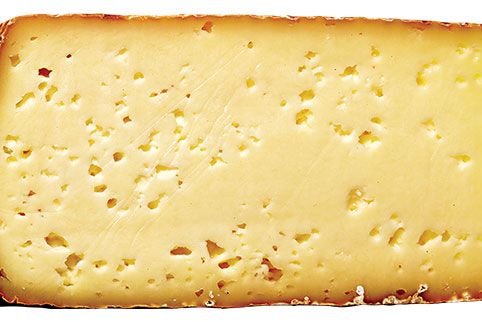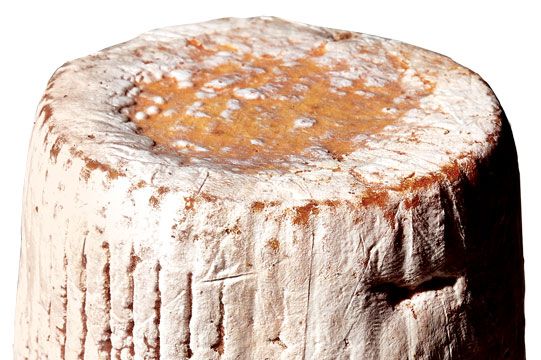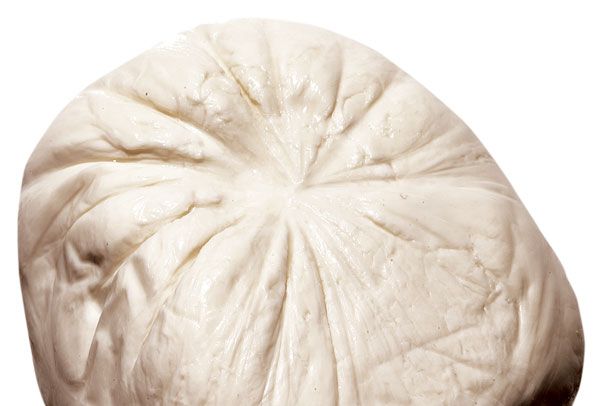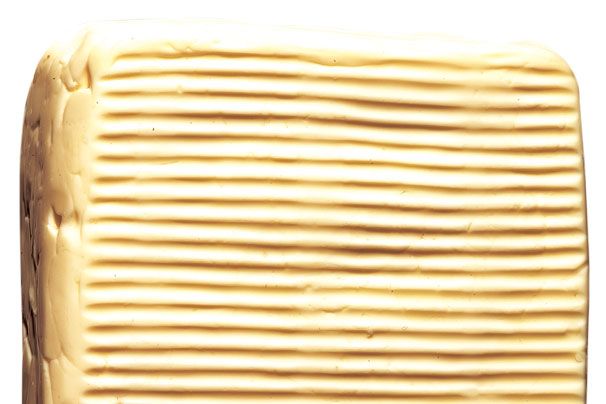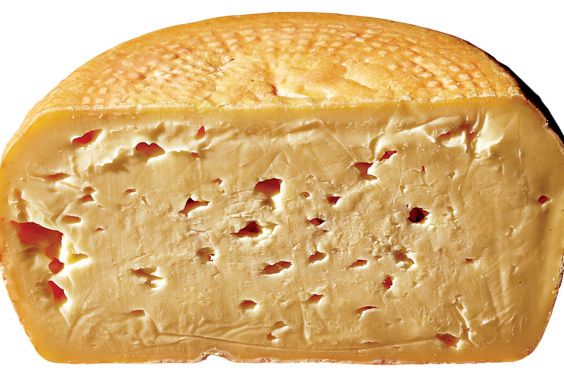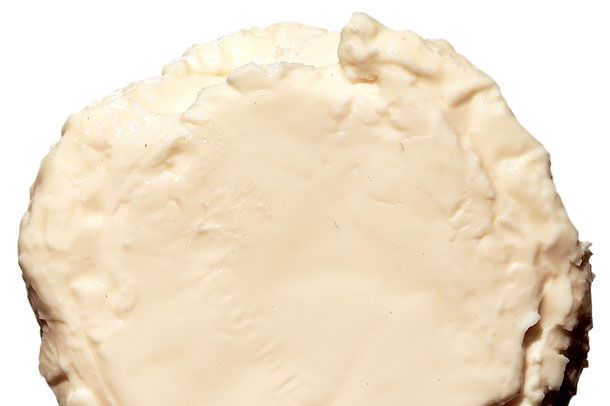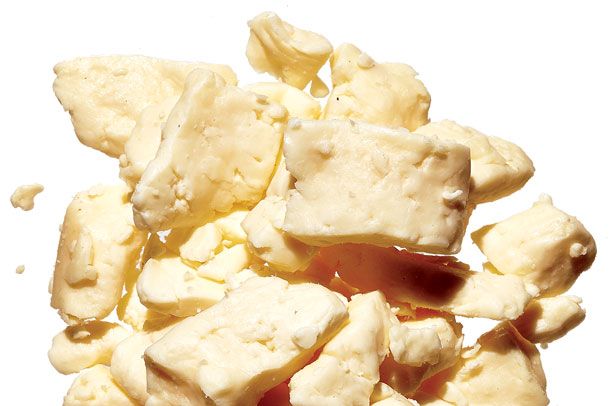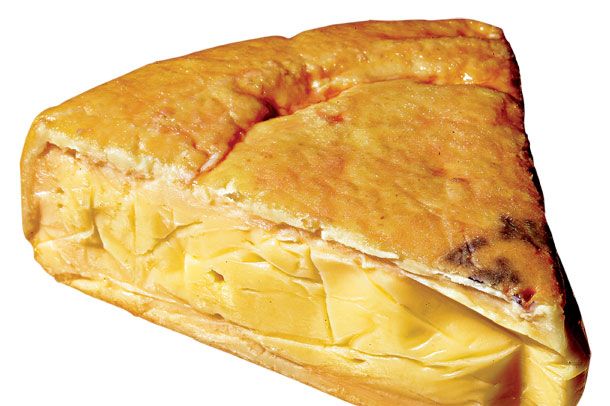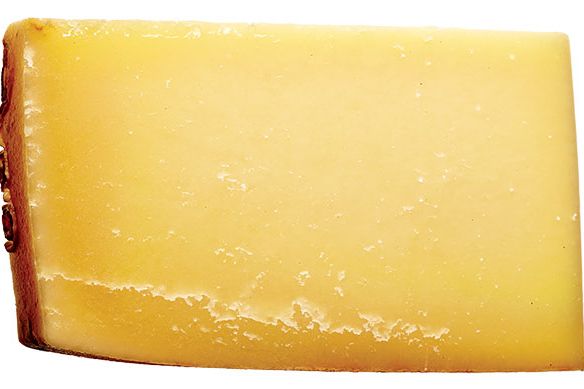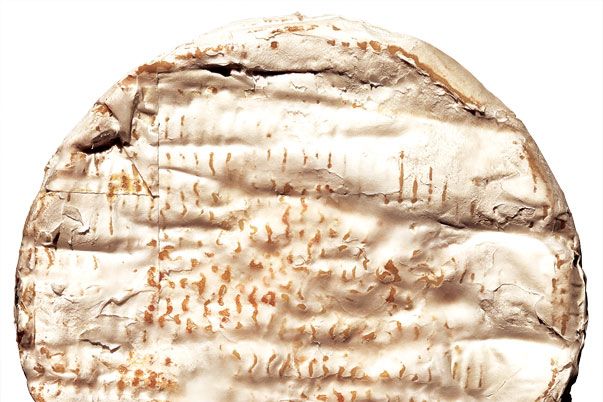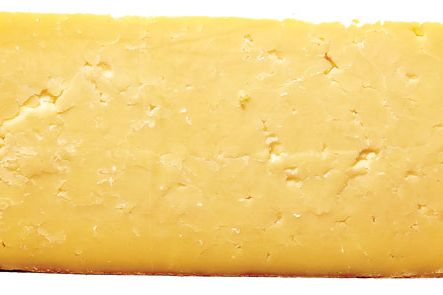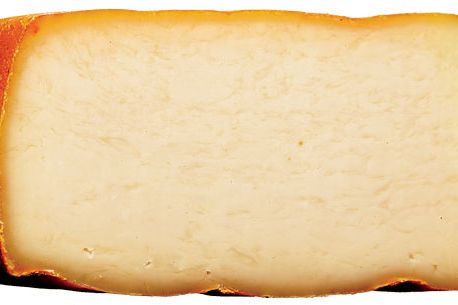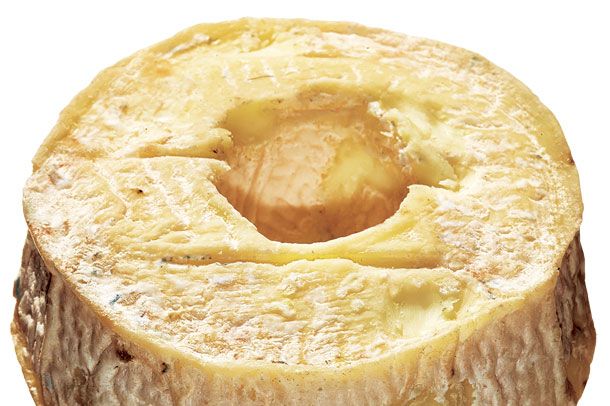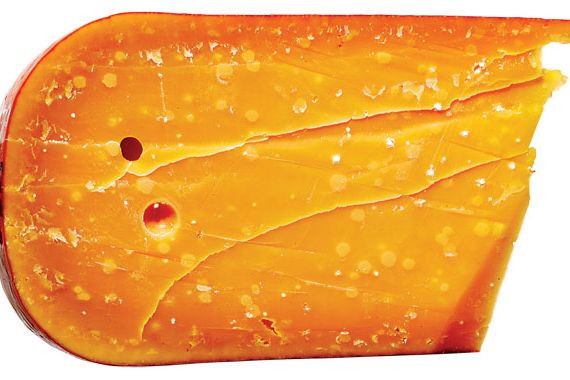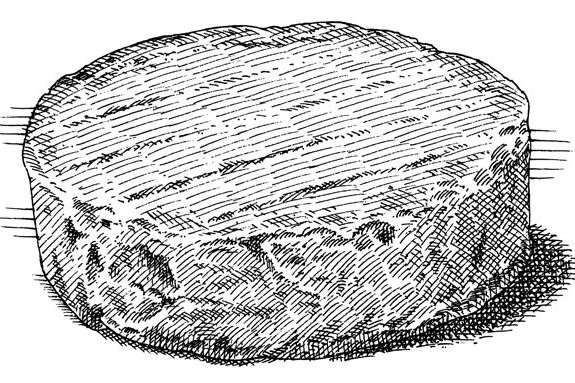Twig Farm’s Fuzzy Wheel.
Photo: Bobby Doherty/New York Magazine
With so many wheels, wedges, tommes, and pyramids out there, in so many styles (from clothbound to washed-rind) and textures (from chalky to runny), exhibiting flavors and aromas that seemingly couldn’t derive from mere milk, there’s never been a better time to eat cheese. The biggest news has been the tremendous growth of American farmstead cheeses, a realm that no one could have predicted three decades ago. Like bread, wine, and coffee, cheese has captured the imagination of not only consumers but also passionate producers and retailers, who fill their cases with the varieties that most excite them, be they microbatch experiments from upstate or even a new artisanal Limburger. We polled many of these mongers, plus importers and plain old curd nerds, to learn about their latest obsessions. Then we tasted a whole lot of cheese and categorized the eclectic results. The following 50 picks represent that diversity, without attempting the impossible task of naming the world’s (or this city’s) best cheeses. You won’t find a rote recitation of classics, but instead the stinky, earthy, oozy, cave-aged, mixed-milk, and even process cheeses of the moment—and where to buy them.
Where to Find Them
Saxelby Cheesemongers
Essex Street Market, 120 Essex St., nr. Delancey St.; 212-228-8204.
No one has done more to give American cheeses their due.
Murray’s Cheese
254 Bleecker St., nr. Cornelia St.; 212-243-3289; and Grand Central Terminal; 212-922-1540.
Terrific selection, lots of classes, and aging caves.
Beecher’s Handmade Cheese
900 Broadway, at 20th St.; 212-466-3340.
Part creamery, part shop.
Lucy’s Whey
75 Ninth Ave., at 15th St.; 212-463-9500; and 1417 Lexington Ave., nr. 93rd St.; 212-289-8900.
All-American in Chelsea; international uptown (plus a wine bar and café).
Bedford Cheese Shop
229 Bedford Ave., at N. 4th St., Williamsburg; 718-599-7588; and 67 Irving Pl., nr. 19th St.; 718-599-7588.
One of the city’s biggest, ripest selections with a swanky new Manhattan branch.
Fairway
Multiple locations.
Without this pioneering cheese counter founded by Steven Jenkins, New York gourmets might still be eating third-rate Brie.
Eataly
200 Fifth Ave., at 23rd St.; 212-229-2560.
An undersung cheese counter not restricted to parm and mutz.
Bklyn Larder
228 Flatbush Ave., nr. Bergen St., Park Slope; 718-783-1250.
The best of Italy and beyond, from the folks at Franny’s.
Whole Foods
Multiple locations.
Home to the Hervé Mons Camembert.
Gastronomie 491
491 Columbus Ave., nr. 84th St.; 212-974-7871.
Erudite cheesemonger Martin Johnson holds forth at the counter.
Di Palo’s
200 Grand St., at Mott St.; 212-226-1033.
A New York landmark. Grab a ticket.
Campbell Cheese and Grocery
502 Lorimer St., at Powers St., Williamsburg; 718-387-2267.
A quaint provisions shop with a strong dairy bent.
*This article appeared in the February 24, 2014 issue of New York Magazine.
Appalachian
Meadow Creek Dairy (Virginia)
Compared with its sister cheese, the washed-rind Grayson, Appalachian is brighter and less beefy and has evolved from its Monterey Jack–style roots to a pressed-curd tomme that defies categorization. Its only ambition: showcasing the nuanced flavors of the pastured herd’s prized milk. $23 a pound at
Saxelby Cheesemongers.
Dunbarton Blue
Roelli Cheese (Wisconsin)
What’s unusual and intriguing about this blue cheese is that it’s barely blue. Cheesemaker Chris Roelli starts out—and ends up—making what is essentially a classic English-style Cheddar—a process that includes pressing the curds. But he also spikes the raw cow’s milk with Penicillium roqueforti, the substance that gives Roquefort its blue-green veins. As pressing restricts the airways in which P. roqueforti thrives (traditional blues are never pressed), the three-month-aged end product is earthy and Cheddarlike, with just a hint of delicious blue mold. $30 a pound at
Murray’s Cheese.
Fuzzy Wheel
Twig Farm (Vermont)
As the name suggests, Michael Lee, the bike messenger turned cheesemonger turned cheesemaker, is proud of the bloomy rind on this aged goat-and-cow’s-milk cheese. And rightly so. That well groomed fluffy mold called poil du chat (cat’s fur) is responsible for all those layers of flavor and the firm but supple texture. $29 a pound at
Saxelby Cheesemongers.
Beecher’s Flagsheep
Beecher’s Handmade Cheese (Washington)
A mixed-milk riff on the creamery’s signature all-cow Flagship. It’s made like a traditional clothbound Cheddar, but with two-thirds cow’s milk and one-third sheep’s, and starter cultures more commonly used in Swiss cheeses. The harmonious result is rich and chewy, with a touch of sheepy sweetness and little of aged Cheddar’s characteristic tang. $32 a pound at
Beecher’s Handmade Cheese.
Estero Gold Reserve
Valley Ford Cheese Company (California)
The Italian-Swiss family behind this Sonoma County farmstead dairy aspired to make something akin to Montasio; the sweet, creamy, slightly crystalline result eats much more like Piave and shares that cow’s-milk crowd-pleaser’s resemblance to Parmigiano-Reggiano. $24 a pound at Lucy’s Whey
Chelsea Market.
Tomme Dolce
Andante Dairy (California)
Accomplished pianist Soyoung Scanlan refers to herself as “soloist” at the pioneering Sonoma County dairy she founded fifteen years ago, and her fan club includes the discriminating likes of Thomas Keller. This semi-firm goat tomme is a newish addition to her repertoire—washed with brandy and June Taylor plum conserves, then aged six months until creamy and salty-sweet. $34 a pound at
Bedford Cheese Shop.
Winnimere
Jasper Hill Farm (Vermont)
The 2013 American Cheese Society Best of Show winner spotlights high-fat, high-protein winter milk, and in the style of Försterkäse and Vacherin Mont D’or, its oozy contents are barely contained by a spruce-bark girdle. A beer wash contributes to the irresistibly woodsy, bacon-y, creamy flavor. $27 a pound at
Saxelby Cheesemongers.
Cagliata
Caputo Brothers Creamery (Pennsylvania)
A trip to Italy inspired Rynn and David Caputo to make cagliata, or curd, from local grass-fed-cow’s milk that’s been cultured, rather than just dosed with vinegar or citric acid. The eight-hour fermentation yields a frozen grocery product that allows the home cook (not to mention chefs at Carbone and Del Posto) to stretch fior di latte with much more flavor than you’ll find in your typical Caprese salad. $17 a pound at
Saxelby Cheesemongers.
Ameribella
Jacobs & Brichford (Indiana)
This Hoosier-farmstead interpretation of Northern Italian semisoft, washed-rind stinkers like Taleggio is made with the raw milk of rotationally grazed cows—somewhat of a rarity in these parts. Square and squat, it’s more bulgy than runny, with a full, savory flavor and lush, dense texture. $30 a pound at Lucy’s Whey
Chelsea Market.
Landaff
Landaff Creamery (New Hampshire)
This semi-firm raw cow’s-milk cheese has a natural gray rind that encases a paste the color of butter with a fragrance to match. It’s moist and mild, faintly tangy, exquisite in its simplicity. The mom-and-pop cheesemakers, Deb and Doug Erb, modeled it after a traditional Welsh Caerphilly for a reason: The town in which they make it was named after the Bishop of Llandaff, Wales, chaplain to England’s King George III. $22 a pound at
Eataly.
Marieke Super-Aged Gouda
Holland’s Family Cheese (Wisconsin)
An 18-month-aged Gouda, made from raw cow’s milk, that you’d swear had been shipped over from the Netherlands. Like the best farmhouse Goudas, it possesses that umami-rich blend of sharp and sweet—like a Parmigiano-Reggiano that’s been infused with caramel—and a texture accented by the crystalline clusters of amino acids called tyrosine that pop in your mouth like Rice Krispies and are a sign of a well-aged cheese. $28 a pound at
Saxelby Cheesemongers.
Pleasant Ridge Reserve Extra-Aged
Uplands Cheese Co. (Wisconsin)
Crafted in the Alpine style of French Beaufort, Pleasant Ridge is the most celebrated American cheese out there. It’s made only from May to October, when the dairy’s rotationally grazed cows are eating fresh pasture. A diet of various grasses, herbs, and wildflowers makes for a richer, more complexly flavored milk, which in turn leads to a super-nutty, deeply-flavored cheese. Weather is a factor, too: When the pasture conditions aren’t perfect, they sell the milk. $30 a pound at
Murray’s Cheese.
Txiki
Barinaga Ranch (California)
Marcia Barinaga’s second cheese follows the same Basque raw-sheep’s-milk-tomme recipe as her first, Basseri, but Txiki’s size (the name means “little”) hastens ripening. It’s made after lambing season, and its flavor is reminiscent of European classics like Ossau-Iraty—sweet, nutty, and a bit fruity. $44 a pound at
Bedford Cheese Shop.
Bay Blue
Point Reyes Farmstead Cheese (California)
You know Point Reyes’s punchy, pungent, razor-sharp Original Blue. This is something like its polar opposite. It’s built along old-world Stilton lines, with a flavor that’s soft and round as opposed to sharp and peppery, and a texture that is crumbly-buttery. $25 a pound at
Bedford Cheese Shop.
Alpha Tolman
Jasper Hill Farm (Vermont)
This Alpine-style wheel is a true communal effort: The raw cow’s milk comes from a nearby farm; the curds are cooked and pressed in a new food incubator in the town of Hardwick; and the brine-washed wheels age in Jasper Hill’s cellars for eight to eleven months, where they evolve from smooth and fruity to crystalline and meaty, with an enticing whiff of caramelized onion. $23 a pound at
Saxelby Cheesemongers.
Brabander Goat Gouda
(Netherlands)
When a few discriminating shops tired of selling Midnight Moon, an enormously popular goat Gouda made in Holland for California’s Cypress Grove, the mongers sought out a less mainstream replacement. To the rescue came Amsterdam-based Gouda specialist Betty Koster, who ages these firm, waxed-rind wheels from six to nine months, just long enough to achieve the cheese’s characteristic creamy texture and buttery-sweet, slightly caramelized flavor. $28 at
Bklyn Larder.
Försterkäse
(Switzerland)
This profoundly stinky brine-washed cheese is held together by a strip of spruce bark. It’s not new, per se, but Swiss cheesemaker Thomas Stadelmann has made some changes, expanding the cheese-to-bark ratio to tone down the woodsy taste. Försterkäse is reminiscent of Vacherin Mont d’Or, but with a paste that doesn’t run, and a saltier, more robust flavor, like Italian salumi, fried eggs, and sautéed onions. $27 a pound at
Bedford Cheese Shop.
Stichelton
(England)
Stichelton (which happens to be the original name for the village of Stilton) was created in response to a certifying organization’s 1989 mandate that, due to health concerns, all Stilton producers must use pasteurized milk. Made with the raw milk of Holstein-Friesian cows, Stichelton is rich and mellow with a wonderfully long finish, and it’s not too much to say that Stichelton picks up where Stilton left off. $34 a pound at
Bklyn Larder.
Cabricharme
(Belgium)
The cheese cognoscenti are increasingly excited about the cheeses coming over from Belgium, like this fairly pungent Trappist-style washed-rind variety, atypically made with raw goat’s milk instead of cow’s. It’s got a thickish edible crust the color of a plain bagel, a light and creamy ivory-white paste, and a goaty tang that nicely offsets its beefy, mushroomy flavor. $26 a pound at
Bedford Cheese Shop.
Jersey Blue
(Switzerland)
Willi Schmid has achieved cult status in the New Swiss Cheese movement for his intuitive, innovative mastery of the flavor nuances of local milk. His blue is buttery, floral, and a two-time winner of the World Jersey Cheese Awards. $38 a pound at
Bedford Cheese Shop.
Ticklemore
(England)
A semi-hard cheese shaped like a flying saucer, Ticklemore has a subtly sweet flavor redolent of herbs and grass, and a moist yet slightly crumbly texture. It’s made from the milk of goats who graze not only on pasture but also some nutritious hedgerows bordering Dartmoor National Park. $32 a pound at
Gastronomie 491.
Challerhocker
(Switzerland)
By tweaking the tightly regulated Swiss recipe for Appenzeller (changing the breed of cow, fat content, type of starter and rennet, size of wheel and aging time), second-generation producer Walter Rass invented a brand-new Alpine mountain cheese. Superlatively creamy and rather dense, the paste tastes of allium and butterscotch in equal measure. $30 a pound at
Whole Foods.
1605 Manchego
(Spain)
An artisanal farmstead Manchego in a sea of mass production, 1605 is made from the raw milk of grass-fed La Mancha ewes, and further distinguishes itself with a natural, unwaxed rind. It’s sweetly sheepy, with a bouquet of serrano ham. $29 a pound at
Bklyn Larder.
Zimbro
(Portugal)
Portuguese cheeses are nothing new, but they have, until recently, been misunderstood. Or so say their boosters, who point to Zimbro as case in point. In the tradition of Portugal’s sheep’s-milk stars, Serra da Estrela and Azeitão, Zimbro is coagulated with thistle rennet, which gives the finished cheese a notably tart taste. This flavor is less defect than ideal complement to the richness of the paste, which, when young and super-soft, can be spooned from the wheel like pudding. $25 a pound at
Bedford Cheese Shop.
Adelegger
(Germany)
This Alpine beauty is the masterwork of a small cooperative of dairy farmers and cheesemaker Evelyn Wild, who brine-washes the 15-pound wheels and ages them for 17 months—long enough to develop the dense and fudgy paste and sweet, nutty flavor one associates with world-class Gruyère. $36 a pound at
Bklyn Larder.
Chiriboga Blue
(Germany)
An unusual young blue named for its maker, Arturo Chiriboga, Ecuadoran by birth and Bavarian by marriage. He transforms organic cow’s milk from a local cooperative into a cheese so mild and mellow it’s fondly known among fans as “blue butter,” with the texture of a triple crème and only the faintest whisper of funk. $32 a pound at
Bklyn Larder.
Anton’s Limburger
(Germany)
Originally a Belgian cheese made by Trappist monks, Limburger became a punch line in America owing to its cartoonishly powerful aroma. Today, most Limburger is produced in Germany. This one is handcrafted from locally sourced, organic milk by the innovative cheesemaker Anton Holzinger. The orange-beige washed rind is unabashedly stinky, but the creamy pale paste is relatively mild and more nuanced than you’d think. $14 for a 7-ounce block at
Bedford Cheese Shop.
Sternschnuppe
(Germany)
Another winner from Evelyn Wild, the woman behind Adelegger, this Alpine-style cheese is washed with red wine and herbs. It has a rustic rind, a moister-than-usual, semi-firm paste flecked with small eyes, and a beefy, slightly funky flavor. $27 a pound at
Murray’s Cheese.
Kunik
Nettle Meadow Farm (New York)
A mold-ripened mixed-milk wheel that combines goat milk’s tang with the tongue-coating richness of Jersey-cow cream, Kunik is a triple crème just this side of cheesecake. As it ages, its firm texture loosens and its flavor grows goatier, but never overwhelmingly so. $30 a pound at
Murray’s Cheese.
Lorenzo
Meadowood Farms (New York)
Like a young Fontina, but made from sheep’s milk, this farmstead cheese has a delicately funky flavor and a supple, pale-yellow paste that makes it a good melter. It’s handcrafted by Veronica Pedraza, a former Saxelby monger, who washes each wheel with hard cider. $32 a pound at
Saxelby Cheesemongers.
Miranda
Vulto Creamery (New York)
Jos Vulto began making cheese in Brooklyn six years ago, but has since built a creamery in the Catskills, where he sources grass-fed milk from a local dairy. Miranda is a pleasingly pungent button washed with Meadow of Love absinthe from Delaware Phoenix Distillery. $16 each at Lucy’s Whey
Chelsea Market.
Mozzarella
Di Palo’s (New York)
Di Palo’s fresh, fragrant mozzarella is soft and tender but not too, with just the right amount of pull. When you cut into a ball, it fairly oozes with its own sweet whey. Lou Di Palo kneads and stretches several batches daily, the same way his great-grandfather Savino did 100 years ago. $7.89 a pound at
Di Palo’s.
Melville
Mystic Cheese Company (Connecticut)
Modeled after Northern Italian Stracchino, this fledgling creamery’s launch product is mild, milky, and a bit gelatinous upon release, but develops more of a delectable tang and velvety texture as it ages. Milk type changes seasonally; winter’s cow will segue to goat in the spring and summer. Even more exciting than the cheese, perhaps, is where it’s produced: rehabbed shipping containers called Cheese Pods, which the owners plan to market to aspiring cheesemakers everywhere. $11 each at
Saxelby Cheesemongers.
Ricotta
Salvatore Bklyn (New York)
Unlike traditional ricotta, invented to repurpose whey once the curds have drained, this stuff uses full-fat Hudson Valley milk, acidified and strained in a cheesecloth until its texture resembles a lemony cross between cream cheese and whipped cream. $18 a pound at
Saxelby Cheesemongers.
Hooligan
Cato Corner Farm (Connecticut)
Mark Gillman brine-washes these one-and-a-half-pound raw-cow’s-milk wheels, ages them for two months, and trucks them over to the Greenmarket on Saturdays. The rind is orange and strong-smelling, the paste sweet and meaty. $26 a pound at
Greenmarket.
American Process Cheese
Blame an infatuation with burger-joint burgers for a new appreciation of preservative-riddled American process cheese. The reason: No other type melts nearly as well without exuding fat and separating. Wylie Dufresne, for one, is a fan, and Nathan Myhrvold gives a recipe in his Modernist Cuisine at Home starring the key ingredient, sodium citrate. At supermarkets everywhere.
Beer Cheese
The highest compliment one can pay Kentucky’s contribution to the cheese-spread canon is that it is “snappy.” Proportions vary, but the building blocks are sharp Cheddar, beer, garlic, and secret spices; Brooklyn brand Floyd Beer Cheese, born in a bar and now stocked on shelves from Ann Arbor to Fort Worth, comes in Original, Spicy Jalapeño, and Smokey Bacon. $9 for a 7-ounce tub at
Gourmet Garage.
Bel Paese
Cheese guru Steven Jenkins calls Bel Paese a cheese for people who don’t like cheese. And, yes, the little foil-wrapped medallions you see in upscale sandwich shops like Soho’s Alidoro are the Italian equivalent of Laughing Cow. But that’s the point: The soft, bland, spreadable cheese adds just the right faintly tangy note to a hero without getting in the way of the cured meats. 45 cents a piece at Raffetto’s (144 W. Houston St., nr. Macdougal St.; 212-777-1261).
Cheese Curds
These squeaky nuggets of cheese potential form as the whey is drawn off acidified, coagulating milk, and their all-American appeal has grown from a cult fan base in Wisconsin. But despite their seeming innocence, they often wind up in culinarily compromising positions—battered and deep-fried, or sprawled over a heap of French fries smothered with gravy in the beloved French-Canadian junk food known as poutine. $7 for about a half pound at
Beecher’s Handmade Cheese.
Pimento Cheese
Consider pimento cheese’s popularity a corollary of the fried-chickenification of New York. It can be found at southern-food restaurants, Smorgasburg, and even in a highfalutin gourmet stall at Essex Street Market, where it’s made with extra-sharp Cheddar, cream cheese, mayonnaise, pimentos, red pepper flakes, and Sriracha. $6 for a 2.7-ounce jar at
Formaggio Essex (120 Essex St., at Delancey St.; 212-982-8200).
Küntener Reblochon
(Switzerland)
The Swiss version of France’s vaunted Reblochon counts among its devoted fans maître fromagers like Artisanal’s Max McCalman and mongers like Bedford Cheese Shop’s Charlotte Kamin, who toss around superlatives like “over the top” and “funky beyond belief.” The barnyardy washed-rind disk is a personal passion of Rolf Beeler, the Swiss cheese avenger whose life mission is sourcing and advocating for his nation’s hidden treasures, often collaborating with their makers on production and flavor profile. $40 a pound at
Bedford Cheese Shop.
Casa Madaio Calcagno
(Italy)
A terrific Pecorino, handmade on small Sardinian farms. Wheels are shipped to natural aging caves outside Salerno, where they’re ripened by the Madaio family, a fourth- generation affineur. Long aging concentrates the cheese’s sharpness, brings out its sweet, herby flavors, and builds a dense- but-not-too-dry texture. $29 a pound at
Bklyn Larder.
Hervé Mons Camembert
(France)
One of the best Camemberts you’re likely to find—and it’s made from pasteurized milk. Produced in Normandy under the supervision of affineur Hervé Mons, it’s full of earthy, truffly, sweet buttery flavor, and the paste is properly sticky-soft as opposed to runny; according to aficionados, a loose texture equals less flavor. $11 for a wheel at
Whole Foods.
Cabot Clothbound Cheddar
Cabot Creamery (Vermont)
The success of this muslin-wrapped, lard-coated collaboration between the supermarket stalwart and Jasper Hill Farm is what facilitated construction of the Cellars at Jasper Hill. After 12 to 14 months in the underground vaults, the wheels acquire the crystalline texture of a proper English Cheddar. $22 a pound at
Saxelby Cheesemongers.
Le Meunier Roquefort
(France)
The Roquefort that French affineur Rodolphe Le Meunier ships to the United States is intensely salty and sweet, but in such perfect balance that the overall flavor seems almost delicate. The texture is wet and cool, like some molecular-gastronomist ice cream that won’t melt at room temperature. $32 a pound at
Gastronomie 491.
Tome d’Aquitaine
(France)
Here’s what makes this a true “Création Jean d’Alos”: The pressed goat-cheese wheels are produced by a Loire dairy cooperative, then transported to the renowned French retailer/affineur’s facilities in Bordeaux, where they’re washed with brine and Sauternes. After four months, they turn semi-firm, silky, and almost milky-sweet, with a fruity, lightly pungent aroma. $26 a pound at
Gastronomie 491.
Torus
Vermont Creamery (Vermont)
A special strain of mold called Geotrichum candidum gives this doughnut-shaped goat’s-milk cheese its powdery appearance and sweet, minerally flavor. The shape, with its increased crust-to-paste ratio, is modeled after the French couronne, or crown, and it’s a favorite among those who find particular pleasure in eating cheese rinds and the rich cream line that lies beneath them. The cheese, a collaboration between Murray’s and Vermont Creamery, is aged in Murray’s caves, 15 feet below Bleecker Street. $11 each at
Murray’s Cheese.
L’Amuse Gouda
(Netherlands) Dutch-cheese renegade Betty Koster buys Gouda young and ages it herself, at higher temperatures and humidity levels than usual, and sells it under the name of her cheese shop. After two years, the so-called cheese candy is hard but creamy, dotted with crunchy protein crystals, and as sweet as salted caramel. $28 a pound at
Bklyn Larder.
Époisses
(France)
Of all the soft cheeses traditionally made from unpasteurized or “raw” milk and aged less than 60 days, and therefore banned from import, this is the one connoisseurs seek out most fervently. While you can increasingly find good pasteurized versions of cheeses like Vacherin Mont d’Or and Camembert, their Époisses equivalents are usually lacking.
Mimolette
(France)
Ever since the FDA detained shipments of this spherical orange cheese last spring, its future as a French import has been in jeopardy. If you do happen to spot it on shelves, it will likely be very young and lacking its characteristic gray, craggy rind—a traditional hiding place for the microscopic mites that are said to contribute to its flavor.
